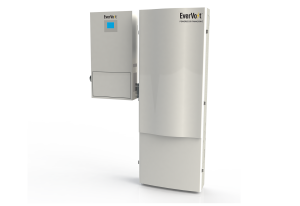One of the hottest topics in solar these days is a solar power battery, particularly Tesla’s solar battery . That is, a battery to shift your solar production to the non-sunny part of the day as well as provide a backup power source for when the grid isn’t working. And if you’ve thought about a solar power battery at all, the product that probably has your maximum attention (or “mindshare”) is the Tesla Powerwall.

EverVolt home energy storage system by Panasonic
But as the Tesla Powerwall is currently extremely hard to acquire (we’ve heard that wait lists are as long as a year), you might wonder if there are any good alternatives? The answer is YES!
In fact, depending on your decision criteria some of the options are probably even better.
How to Choose a Battery?
If you google solar power batteries you’ll typically find lots of tech talk (and a lot on Tesla’s solar battery). Sort of like when computer companies talk about CPUs and RAM and Gigabytes. Useful stuff for sure and to some of us (like me!), very engrossing. But in truth I know many of you are put to sleep by it. So instead let’s get to the basic parameters of what might make a specific battery good or bad for you with as little “tech talk” as possible.
Battery Differences – Does Price Tell a Story?
One seemingly easy way to measure battery options is price and a low price is in fact how Tesla managed to garner a lot of attention. But truthfully, the advertised price for the Tesla Solar Battery leaves a whole lot of things out, most importantly a lot of the costs relating to the installation. We’ve installed a few and given what they charge us for materials, and what it takes to complete the install, their price is somewhat fictional. Assuming we can even get you one.
But if we put that Tesla Solar Battery issue aside, battery options can in fact cost you anywhere from around $10,000 to $20,000 or more these days. So what makes them different and why would you pay more?
The first most obvious differentiator that tends to track with the price is the amount of power you can store. We frequently get calls from people that want to run their whole house on a battery if the power goes out, but that’s generally a very costly goal. Instead, you’ll likely want to think about the minimum amount of things you want to be able to run. For example, you’d like to keep your boiler/furnace running, the refrigerator, a water or sump pump, a few lights? The less you include in that list, the lower your overall battery cost.
Second, how long do you want your battery to keep performing before the sun shines again and recharges it? Again, the shorter the time frame, the lower your cost. Those two measures – the amount of power and time – are interrelated of course (more of one can be had by requiring less of the other), but they clearly drive your cost.
But a third criteria, often ignored, is how long do you want your battery to last over time? That is, will it still be working for you 5, 10, or even 20 years from now? We don’t think about that much, but in truth it may be the most costly factor of the three.
If you have kept a single smartphone more than a few years that experience may help you understand these criteria. Simply put, a lot of phone batteries tend to poop out after they are 2 or so years old. That’s because they last for a given number of “cycles” (charge/discharge cycles to be more precise) and then they begin failing to hold a charge. When it happens to your phone you know it and at that point you’ll need a new phone – or at least a new battery.
So does this apply to solar power batteries? Yes it does. And differences between battery options can be quite stunning.
The lower cost options typically can handle charging and discharging for eight to ten years of a daily charge/discharge cycles (for example, Tesla’s). At that point, you’re going to have to replace the batteries (a very large portion of the system’s overall cost). But some of the higher priced options can cycle daily for well over 20 years! Yes, they may cost a lot more at the start, but you’ll also avoid hassling and spending money on getting replacements only 8 or 10 years out. What’s best for you? Only you can decide.
Footprint and Beauty
Another consideration when you look at a solar power battery is its size and form factor. Some are kind of square and need to be hung on a wall. But as you might guess they are heavy, so they can’t be on just any wall. Others are tall and slim and sit on the floor, clearly aiming to look kind of cool (at least if I catch their marketing department’s intent correctly).
And that difference might matter to you because here in the Northeast your battery can’t be outside or in an unheated garage. That’s because batteries are killed by heat and cold robs them of their power (at least while they remain frozen). So you may in fact have to install a battery in your conditioned or “living space” so what it looks like may matter to you.
Beyond that we could drill down into things like whether a specific battery piggybacks on your panel’s inverter or has its own inverter, what each system’s roundtrip efficiency is versus another, or perhaps the ability to add more batteries at a later date. But like I said, those are technical considerations we were looking to avoid here. At least until you’ve narrowed the field to the solar power batteries you would be willing to live with.
So in sum, choosing a battery (at least at the start) may come down to just four questions:
- Which batteries can deliver the power you need (what do you need to keep running)?
- How long can your options provide that power without recharging?
- How long will your choice last before the batteries will have to be replaced?
- And finally, how big or what shape are your options and will they work for the location options you have in mind?
If you’d like to discuss the Tesla Solar Battery further and explore some of the multiple manufacturer options, just let us know. We’d be glad to help.




